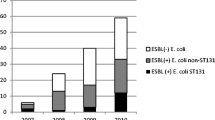Abstract
Plasmid-mediated quinolone resistance (qnr) genes confer low-level resistance but provide background for selection of highly-resistant strains. We investigated their prevalence and significance in clinical Enterobacteriaceae bacteremic isolates in Hong Kong. A prospective, hospital-based study was conducted (January 2008 to March 2009). Consecutive, non-duplicate blood isolates of extended-spectrum-β-lactamase (ESBL) and/or plasmid-mediated AmpC (PMAmpC) β-lactamase-producing Enterobacteriaceae were collected and subjected to qnr genes detection using multiplex PCR. Direct sequencing was performed to characterize the qnr and the co-existing bla genes. Clinical and microbiological variables, including antimicrobial resistance profiles, were compared between infections by ‘qnr-positive’ and ‘qnr-negative’ Enterobacteriaceae. Altogether 199 ESBL/PMAmpC-producing Enterobacteriaceae isolates were studied. qnr genes were detected in 20 % (qnrB, n = 24; qnrS, n = 16; qnrA, n = 0), of which 85% were Klebsiella spp. There was a strong association with PMAmpC genes (qnrB and DHA-1; p < 0.001). ‘qnr-positive’ isolates were more commonly hospital-acquired (60.0% vs 35.8%; adjusted OR 2.68, 95%CI 1.32–5.46) and multidrug-resistant (e.g. amoxicillin-clavulanate 90–100%, piperacillin-tazobactam 40–57%, ceftazidime 53–78%; sulfamethoxazole/trimethoprim 60–70%; ciprofloxacin 53–65%, levofloxacin 35–48%). Patients with ‘qnr-positive’ Enterobacteriaceae bacteremia had a higher 30-day mortality (45% vs 22%, p = 0.003). High Pitt bacteremia score, development of pneumonia, and failure to receive susceptible fluoroquinolone (adjusted HR 4.27; 95%CI 1.45–12.61) or carbapenem (adjusted HR 3.04; 95%CI 1.49–6.20) treatment were independent factors associated with death. A high proportion of ESBL/PMAmpC-producing Enterobacteriaceae (typically Klebsiella) bacteremic isolates carried qnr. These strains were multidrug-resistant, which was associated with inappropriate treatment and high fatality. Further dissemination of qnr and selection of fluoroquinolone/β-lactam-resistant strains should be closely monitored and controlled.
Similar content being viewed by others
References
Jacoby GA, Walsh KE, Mills DM et al (2006) qnrB, another plasmid-mediated gene for quinolone resistance. Antimicrob Agents Chemother 50:1178–1182
Strahilevitz J, Jacoby GA, Hooper DC et al (2009) Plasmid-mediated quinolone resistance: a multifaceted threat. Clin Microbiol Rev 22:664–689
Robicsek A, Strahilevitz J, Sahm DF et al (2006) Qnr prevalence in ceftazidime-resistant Enterobacteriaceae isolates from the United States. Antimicrob Agents Chemother 50:2872–2874
Corkill JE, Anson JJ, Hart CA (2005) High prevalence of the plasmid-mediated quinolone resistance determinant qnrA in multidrug-resistant Enterobacteriaceae from blood cultures in Liverpool, UK. J Antimicrob Chemother 56:1115–1117
Park YJ, Yu JK, Lee S et al (2007) Prevalence and diversity of qnr alleles in AmpC-producing Enterobacter cloacae, Enterobacter aerogenes, Citrobacter freundii and Serratia marcescens: a multicentre study from Korea. J Antimicrob Chemother 60:868–871
Yang H, Chen H, Yang Q et al (2008) High prevalence of plasmid-mediated quinolone resistance genes qnr and aac(6')-ib-cr in clinical isolates of Enterobacteriaceae from nine teaching hospitals in China. Antimicrob Agents Chemother 52:4268–4273
Clinical and Laboratory Standards Institute (2008) Performance standards for antimicrobial susceptibility testing: eighteenth informational supplement M100-S18. CLSI, Wayne, PA, USA
Coudron PE, Moland ES, Thomson KS (2000) Occurrence and detection of AmpC beta-lactamases among Escherichia coli, Klebsiella pneumoniae, and Proteus mirabilis isolates at a veterans medical center. J Clin Microbiol 38(5):1791–1796
Kim J, Lim YM (2005) Prevalence of derepressed ampC mutants and extended-spectrum beta-lactamase producers among clinical isolates of Citrobacter freundii, Enterobacter spp., and Serratia marcescens in Korea: dissemination of CTX-M-3, TEM-52, and SHV-12. J Clin Microbiol 43:2452–2455
Perez-Perez FJ, Hanson ND (2002) Detection of plasmid-mediated AmpC beta-lactamase genes in clinical isolates by using multiplex PCR. J Clin Microbiol 40:2153–2162
Ho PL, Ho AY, Chow KH et al (2005) Occurrence and molecular analysis of extended-spectrum β-lactamase-producing Proteus mirabilis in Hong Kong, 1999-2002. J Antimicrob Chemother 55:840–845
Cattoir V, Poirel L, Rotimi V et al (2007) Multiplex PCR for detection of plasmid-mediated quinolone resistance qnr genes in ESBL-producing enterobacterial isolates. J Antimicrob Chemother 60:394–397
Korvick JA, Bryan CS, Farber B et al (1992) Prospective observational study of Klebsiella bacteremia in 230 patients: outcome for antibiotic combinations versus monotherapy. Antimicrob Agents Chemother 36:2639–2644
Wu JJ, Ko WC, Wu HM et al (2008) Prevalence of qnr determinants among bloodstream isolates of Escherichia coli and Klebsiella pneumoniae in a Taiwanese hospital, 1999-2005. J Antimicrob Chemother 61:1234–1239
Hsueh PR, Badal RE, Hawser SP, Hoban DJ, Bouchillon SK, Ni Y, Paterson DL; 2008 Asia–Pacific SMART Group (2010) Epidemiology and antimicrobial susceptibility profiles of aerobic and facultative Gram-negative bacilli isolated from patients with intra-abdominal infections in the Asia-Pacific region: 2008 results from SMART (Study for Monitoring Antimicrobial Resistance Trends). Int J Antimicrob Agents 36:408–414
Chong YP, Choi SH, Kim ES et al (2010) Bloodstream infections caused by qnr-positive Enterobacteriaceae: clinical and microbiologic characteristics and outcomes. Diagn Microbiol Infect Dis 67:70–77
Lautenbach E, Patel JB, Bilker WB, Edelstein PH, Fishman NO (2001) Extended-spectrum beta-lactamase-producing Escherichia coli and Klebsiella pneumoniae: risk factors for infection and impact of resistance on outcomes. Clin Infect Dis 32(8):1162–1171
Robicsek A, Jacoby GA, Hooper DC (2006) The worldwide emergence of plasmid-mediated quinolone resistance. Lancet Infect Dis 6(10):629–640
Martinez-Martinez L, Pascual A, Jacoby GA (1998) Quinolone resistance from a transferable plasmid. Lancet 351:797–799
Rodríguez-Martínez JM, Briales A, Velasco C et al (2011) Discrepancies in fluoroquinolone clinical categories between the European Committee on Antimicrobial Susceptibility Testing (EUCAST) and CLSI for Escherichia coli harbouring qnr genes and mutations in gyrA and parC. J Antimicrob Chemother 66(6):1405–1407
Poirel L, Pitout JD, Calvo L et al (2006) In vivo selection of fluoroquinolone-resistant Escherichia coli isolates expressing plasmid-mediated quinolone resistance and expanded-spectrum beta-lactamase. Antimicrob Agents Chemother 50:1525–1527
Acknowledgments
This study was supported by a direct research grant (reference number 2041346) from the Chinese University of Hong Kong.
Conflict of interest
The authors declare no conflict of interest.
Author information
Authors and Affiliations
Corresponding author
Rights and permissions
About this article
Cite this article
Lee, C.C., Lui, G., Ip, M. et al. Frequent detection of plasmid-mediated quinolone resistance (qnr) genes in multidrug-resistant Enterobacteriaceae blood isolates, Hong Kong. Eur J Clin Microbiol Infect Dis 31, 3183–3189 (2012). https://doi.org/10.1007/s10096-012-1683-x
Received:
Accepted:
Published:
Issue Date:
DOI: https://doi.org/10.1007/s10096-012-1683-x




